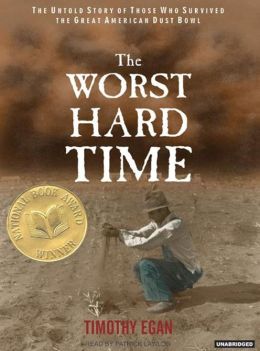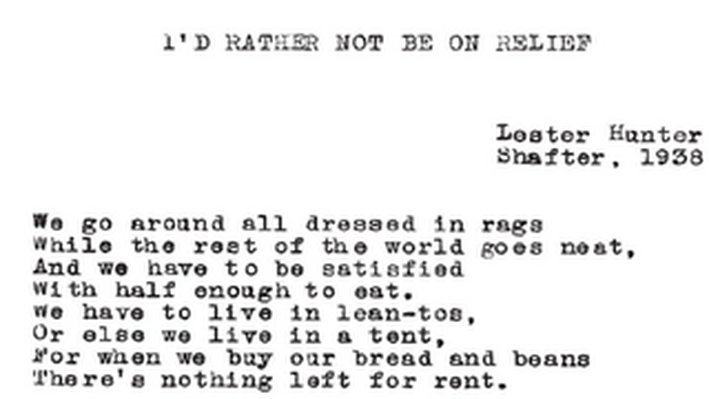I settled on the family
experience during the Dust Bowl in the United States. Rather than going broad
and discussing how the U.S. government dealt with the Dust Bowl, or the science
of it, I felt that it would be most interesting to students to learn about how
individuals and families were affected. This unit would be on the Dust Bowl,
and I may actually have the opportunity (fingers crossed) to teach this unit
later this semester! The 9th grade social studies class I teach
focuses heavily on reading historical texts “like a historian,” so I would
definitely look at different texts this way. To best educate an historical
phenomenon, as well as the historical thinking skills needed to be a successful
student “historian,” I would use varying texts, ranging from content-driven, to
primary sources, to multimedia, etc. This would help students have the best
understanding of the subject as possible, as well as keep them engaged in the
topic throughout the unit.
1. “Interactive Dust Bowl” –
multimedia/visualization source
This “text” was created as
an accompaniment to the Ken Burns documentary, The Dust Bowl. It allows you to click through scenarios that Dust
Bowl families faced, looking at haunting photos of the Dust Bowl. The text is
very accessible to students, as all of mine have their own school-issued iPads.
I also selected this text specifically because the language is easy to
understand. It doesn’t use many difficult words, or long and complex sentences,
thus it would be a good place to start for students learning about the Dust
Bowl. StoryToolz gives this text a grad 7 readability score, which makes sense
to me. More than half of my students read above 7th grade levels,
thus overall this wouldn’t be a text that is too complex for students. For
students that aren’t quite at grade level, there are a few terms that may need
instructional support: embark, profit, expand, descend, and geographic.
This text would be used as
an introduction to the Dust Bowl. Though students wouldn’t have a lot of
background knowledge, this would help build it, as well as engage students by
using technology.
Thinking Question: What
would you do if your family farm failed for several years? Stay put and keep
working, or move somewhere else?
2. Film The Dust Bowl, by Ken Burns
Admittedly, part of the
reason I selected this film was because I just really love it. Ken Burns films
are just amazing. This film chronicles the family experience during the Dust
Bowl era. The documentary was released in 2012, making it very modern, though
the content is obviously 80 years old. It features interviews with Dust Bowl
surivors (primary sources), which is an important element of historical
reading. The documentary would be viewed during class, and some students would
be able to view some segments at home on their iPads. To determine text
complexity, I input the transcript from part of the film into StoryToolz. It
scored a 9th grade level, which is in line with the majority of the
students in the class. Giving students text at the appropriate grade level
would ensure that students won’t get too frustrated watching a film that they
don’t understand. I agree with the score, I think the vocabulary and sentence
structure is pretty appropriate for 9th graders. Some important
vocabulary words for this film are: reap, combine, expanse, rape (as in “they
raped the land”), resemble, mustard gas, topsoil.
This text would be used to
help introduce the Dust Bowl, as a follow up to the interactive Dust Bowl site.
Using film, showing photos, interviews and clips, will help engage students in
the subject, as well as get the important background information that they’ll
need. Part of being an effective teacher is using differentiation when
teaching, and students who are more visual would get more out of watching a
film than reading a textbook or a website.
When watching the film, I’d
ask students to compare the experiences of the people interviewed in the film
with their answers from the previous text, “What would you do if your family
farm failed for several years? Stay put and keep working, or move somewhere
else?”
3. Book (Print), Out of the Dust, Karen Hesse
I’m so excited at the
possibility I might teach this book in a class! It was my favorite book in like
3rd grade, and I’ve read it at least ten times. I think the reason why this
book is so interesting is because, though it’s historical fiction, it’s so
readable. It follows Billie Jo, a girl living in the heart of the Dustbowl, the
panhandle of Oklahoma. It shows Billie Jo’s struggles, along with those of
other families trying to survive the Dust Bowl. The structure of the book is
free verse poetry, which provides students with a different means of getting
information about the Dust Bowl. It will engage students by containing the
narrative of one girl’s story, as well as a unique type of text that may engage
students that don’t normally enjoy reading. StoryToolz rated this book around a
4th grade reading level, and because it’s free verse, it would be a
breeze for most students to read most, or all, of it. Important words to go
over would include: what free verse poetry is, Panhandle, and FDR.
Thought Question: How does
Billie Jo’s story compare to other peoples’ stories that you’ve seen or read?
How does the use of free verse affect your opinion of the book?
4. Book (Print), The Worst Hard Time: The Untold Story of
Those Who Survived the Great American Dust Bowl, Timothy Egan
The Worst Hard Time is a National Book Award Winner following the experiences of those
living during the Great Depression’s Dust Bowl. Egan interviewed survivors who
were as interesting as any nonfiction book. These firsthand accounts of life in
the Dust Bowl are informative, but the language is also very creative and
engaging. I would use this text in scaffolding, because the language is more
difficult than Out of the Dust. I’d
probably use it after the other three texts because it’s the most difficult to
read in terms of vocabulary and sentence structure. The aim, though, is to
engage students in reading at higher levels to encourage growth and literacy.
Story Toolz rated the book at varying levels, some portions were lower level,
while other sections of text I input for quantitative analysis were rated at a
college level. Because the book balances several reading levels, it would be
good for scaffolding to help students get better at reading.
Thought Question: How
reliable are the stories that you’re reading? Are they corroborated by any
other sources you’ve read?
5. (Print) I’d Rather Not Be On Relief, Lester
Hunter
These lyrics are from a song
written by Lester Hunter in 1938. The song was written about the Dust Bowl
experience, and is somewhat similar to Woody Guthrie music. It’s written from
someone experiencing the Dust Bowl’s hardships point of view. This text is
great because students may be able to better relate to music and lyrics. I’m
still looking for a youtube clip of the song, but if I found it, I would
accompany the lyrics by playing the song. It’s a different way of giving
information about the Dust Bowl. The average grade level for this text is about
8th grade, which seems accurate. Some of the vocabulary would be
difficult for the students so it would need to be accompanied by a section of
going over vocabulary. I would probably use this to engage students who might
be slipping after doing a lot of more intense reading with the other print
texts. Some vocabulary: lean-to, WPA, gypsy, dickens.
Thought Question: Does this
song accurately represent the experience of the Dust Bowl family? Why? How do you
know?
6. Photos (Print), Migrant Farm Families, Dorothea Lange
Collection of Dust Bowl Photos
I really enjoy analyzing
photos as part of a text analysis. Though there isn’t any reading necessarily
associated with them, they can really help engage students and teach them a
lot. In some cases photos can teach us what written texts can’t. Analyzing
photos is an important aspect of reading like a historian as well. These photos
were taken by Dorthea Lange as she followed families in the central United
States, and as they headed west in search of more opportunities for success. The
photos don’t have a quantitative text complexity, but I do think that looking
at photos is more difficult than reading some texts. I’d use this “text” last
because then students could use all of the knowledge they’ve built up reading
the other texts to interpret and analyze these photos. It’s also a good way to
summarize the unit in general. I would have to go over how to analyze photos
again, though I have spent a lot of time looking at photos with my students.
Thought Question: what can
you conclude from looking at this/these photos? How do you know?






